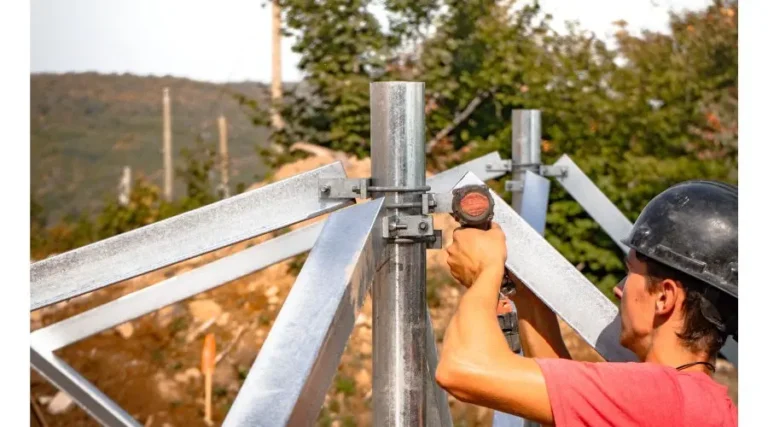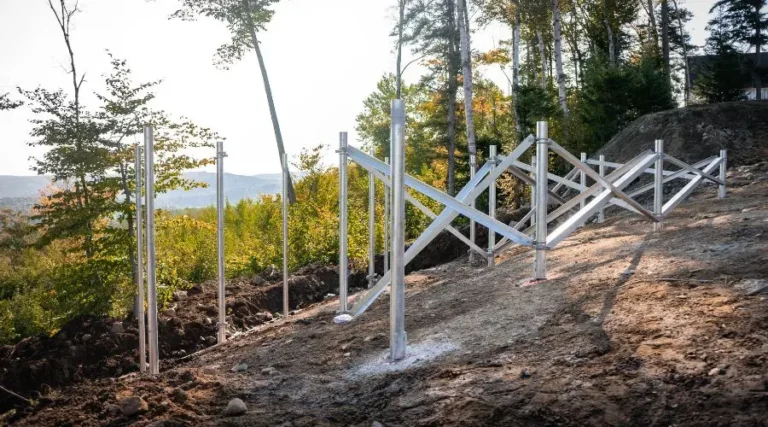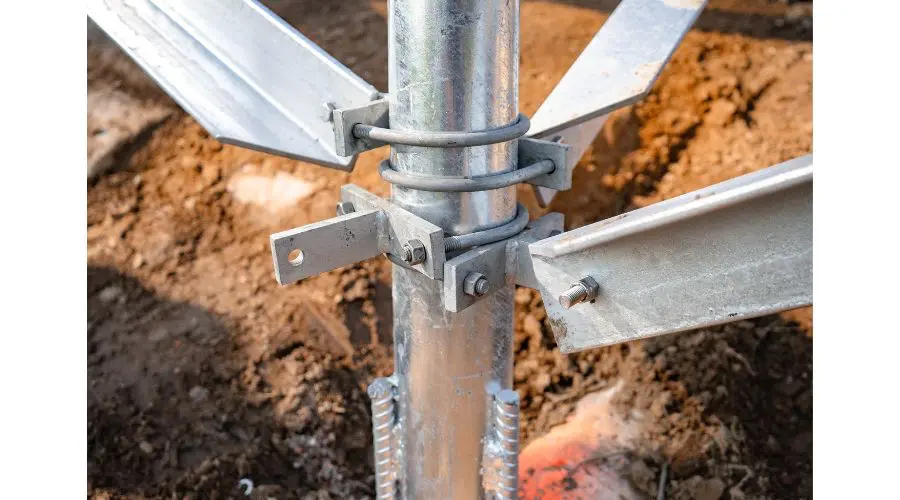Building your own home or chalet in a mountainous region is a dream come true. But there is one obvious obstacle: a sloped site. Will the building settle over time? Choosing the appropriate foundation solution will prevent this problem.
Wondering if you should go with a concrete foundation or screw piles for sloped terrain? Screw piles are very efficient, economical and adaptable to all types of terrain.
- In this article, we address the main challenges – and their solutions — for installing helical piles on a sloped terrain.
Always hire experts to install screw piles, especially if your land presents specific challenges such as slopes.

What Are The Construction Challenges Affecting Sloped Areas?
Most construction projects involving a house, garage or other big structure require a foundation. How to make sure it is solid and secure?
- Building on a slope is always more difficult than on flat terrain.
- There are always concerns about lateral stability.
Helical piles present distinct advantages:
- The piles are customizable.
- A simple construction process, adapted for sloped construction.
- No digging or compaction work required, which may help to keep the soil stable.
- The piles can be adjusted to factor in the lateral pressure.
Why Choose Screw Piles For A Sloped Terrain?
Screw pile systems are designed by engineers. They take into account compression, tension and lateral forces that will be placed on the piles, which leads to the choice of appropriate shaft diameter and helix diameter, as well as number of piles needed. More specifically:
- Some of the helical piles can include a second helix.
- Some piles can be installed at an angle into the slope (battered piles) and welded into the main bracket system.
- Angle bracing is used to strengthen the structure above the ground.
In the end, the array serves as a complete structural unit to support the overall load.
Screw Piles For Sloped Terrain: Lateral Stability Concerns
Construction on sloped terrain needs to factor in lateral stability concerns. Unlike flat ground construction, sloped surfaces introduce horizontal (lateral) forces. The steeper the slope, the more pronounced this lateral earth pressure becomes. Different parts of the foundation system may experience varying loads.
Moreover, slopes are inherently less stable than level ground because gravitational forces want to move the soil downhill. Traditional foundation methods were not designed to handle these conditions. On a slope, they often require expensive soil stabilization measures before construction can begin.
But helical piles can get the job done much faster! That being said, careful engineering of the pile system is absolutely necessary to ensure uniform support.

Do You Need Piles With A Double Helix Configuration?
Double helix configurations represent an advanced engineering solution for sloped construction. The deeper helix provides primary bearing support and the upper one helps resist uplift forces.
This type of screw pile has two helical plates spaced along the shaft. The larger helix is usually positioned at the bottom and there is a smaller one higher up. Why two helical plates?
- To increase the pile's bearing capacity.
- To provide enhanced resistance to both vertical and lateral forces.
- By engaging more soil volume.
- By distributing loads across multiple bearing zones.
Engineers will precisely calculate the spacing between the helical plates based on soil conditions and structural requirements.
Should You Install Battered Piles?
Battered piles are piles installed at strategic angles rather than vertically. They are another solution to manage lateral forces on sloped construction sites.
A geotechnical analysis can determine the appropriate angle and positioning to ensure optimal resistance to sliding. Typically, angles range from 15 to 30 degrees from vertical. The piles are positioned to directly counteract the anticipated lateral forces.
The main advantages of using battered piles are:
- Providing superior lateral stability.
- To significantly reduce the total number of foundation elements needed, which helps you save money!
Installation requires specialized equipment:
- Drilling has to be done at precise angles to insert the piles at the right angle, taking into account different soil layers, to achieve the intended load distribution.
- Even small deviations from the design angle can impact resistance to lateral forces.
- Connection details such as custom-welded brackets need to transfer loads efficiently between the vertical and angled piles. Professional welding is critical to the foundation's stability.
Is Angled Bracing Necessary?
Above-ground structural bracing systems provide an additional layer of lateral stability. They act as a complement to the double helix configuration and battered piles. They help reduce the lateral pressures on the foundation system.
What is angled bracing?
- Diagonal steel braces connecting vertical posts and horizontal beams.
- Connections typically involve bolted or welded joints.
- Angle and size take into account wind loads, seismic, and lateral forces.
Once finished, you obtain a triangulated framework.
However, bracing can have a negative impact on your home’s aesthetic. To counteract this problem, you might ask your contractor to use cable bracing systems or position braces to frame openings (rather than obstruct them).

Screw Piles For Sloped Terrain: How Deep Do The Piles Need to Go?
Screw piles can be driven very deep into the ground, for example over 20 feet deep on a sloped terrain that requires it. If needed, you can add extensions to make the shaft longer.
By measuring torque on site, professionals make sure each pile will go deep enough so that the helix is locked into competent soil. They measure the torque off the drill head from the installation equipment, which is then converted to a bearing capacity.
This means helical piles can be installed much deeper than concrete foundations.
What To Do Before Installing Screw Piles On a Sloped Terrain?
Even if screw piles are a great solution, don’t go in headfirst. Before taking the plunge, follow expert advice.
Consult professionals:
- Building on sloped terrain involves higher costs compared to building on flat ground because of the special equipment to ensure stability.
- Engineers are a crucial part of the process: They analyze load-bearing capacity, taking into account the presence of clay in soil or poor-quality soil such as backfill.
Perform a soil study:
- A soil study is necessary to know the type of soil and its characteristics. In turn, this will determine the ideal foundation system for your project.
- Ask your city or municipality to provide geotechnical data (and hand them to your contractor).
Receive Screw Piles Offers and Start Building!
Companies specializing in the installation of screw piles are used to working on sloped ground, narrow sites, and other difficult spaces.
If you want to build a home or bigger structure on sloped ground, screw piles will provide strength, resistance and flexibility to your building. Their adaptability is key to your success: Install the piles at a depth sufficient to minimize the risks of landslides and erosion, add sufficient bracing, and follow any other advice from professionals!
Ready to start building on screw piles?
- Fill out our form to find a trusted crew specializing in screw piles for sloped terrain. It’s free and there's no obligation.
Helical piles will bring peace of mind to your new home – you can relax and enjoy the view!


